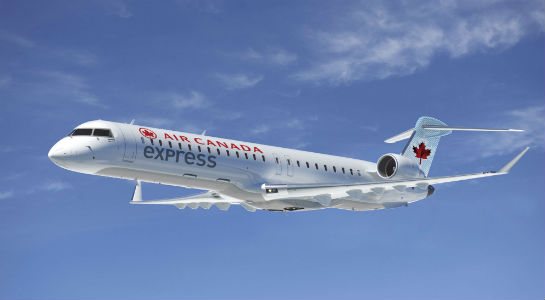Estimated reading time 7 minutes, 42 seconds.

In addition to a trade show component, the event also features media updates from major manufacturers, who report on new products, market share, and future plans.
The first to the podium was Bombardier Commercial Aircraft, whose representatives were in a decidedly upbeat mood following the announcement of a major order for up to 125 C Series aircraft from Delta Air Lines.
Colin Bole, senior VP commercial, told the press that Delta representatives were “equally excited” about the C Series joining their fleet. He said Bombardier took the aircraft down to visit the airline’s Atlanta, Ga., headquarters shortly after the order was announced.
Meanwhile, preparations are moving full speed ahead for the CS100’s entry into service with launch customer Swiss International Air Lines. The first aircraft is due to be delivered in June, with the inaugural revenue flight scheduled for July 15.
As the OEM works to firm up Air Canada’s letter of intent for up to 75 C Series CS300 aircraft, Bombardier also reported developments from its CRJ regional jet program.
Patrick Baudis, VP of marketing for Bombardier Commercial Aircraft, told reporters that the CRJ family is now the third-best selling aircraft family of all time.
He said a recent passenger survey revealed that travellers are looking for a more seamless experience between regional and mainline aircraft, leading Bombardier to make some significant improvements to the CRJ cabin.
Features of the interior upgrade—which will initially be available on the CRJ900 and can be installed as a retrofit option—will include 50 per cent larger wheels-first overhead business cabin bins, a more spacious lavatory and entrance area, integrated cabin connectivity with more options for in-flight entertainment, and improved lighting.
Baudis said that although the new cabin enhancements will first be introduced on the CRJ900, they will also apply to other members of the family as well.
Bombardier is seeking a launch customer for the CRJ900 cabin retrofit, which will be available in about one year.
In the meantime, Mitsubishi Aircraft Corp. is continuing flight testing of its MRJ, scheduled for entry into service in 2018. With five prototypes currently undergoing flight testing, Hideyuki Kamiya, the OEM’s head of strategic marketing, said all is going smoothly as the company works to expand the MRJ’s flight envelope and test emergency systems and procedures.
Flight test aircraft number one (FTA 1) took to the air on Nov. 11, 2015, and FTA 2 is expected to complete its maiden flight towards the end of May 2016.
Kamiya reported that Mitsubishi recently built a new final assembly hangar for the MRJ program. The 473,612 square-foot hangar (44,000-square-metres) has enough capacity to manufacture up to 10 aircraft per month.
He also said the company is looking to move up the proposed start date for its U.S. flight testing from the end of 2016 to this summer, if possible. Flight testing for the MRJ90 and MRJ70 aircraft will be conducted at the company’s facilities at Grant County International Airport, located at Moses Lake, Wash.
European turboprop manufacturer ATR is also focusing on the U.S., as it moves to increase North American market share for its ATR 42 and 72. Currently, there are more than 200 ATR operators in 100 countries, said company CEO Patrick de Castelbajac, who added that an ATR aircraft takes off or lands somewhere in the world about every eight seconds.
He said that many shorter routes (around 80 statute miles) that are currently served by regional jets would be better flown by turboprop aircraft. “We believe the ATR family is a good solution for these routes. It’s good for the environment and the economy to replace older, inefficient RJs with new ATRs,” said de Castelbajac.
Inefficient short-haul jet operations represent an opportunity for ATR, as does the aging U.S. turboprop fleet, where aircraft average 21 years of age. De Castelbajac said efficient ATR aircraft can also restore connectivity among smaller U.S. cities, which jet operators may have deemed unprofitable.
The OEM brought a new ATR 72-600 aircraft to Charlotte during the RAA show, where it was available for viewing on the static display. The stop was part of a larger North American demo tour from May 2 to 13, designed to highlight the ATR family’s operational features.
“We have the right product for regional operations here in the U.S.,” concluded de Castelbajac.
Engine updates
Kathy MacKenzie, general manager of regional engines and services for GE Aviation, provided an update on the CF34 engine family. First introduced in 1992, the CF34 is now in service with more than 130 operators in about 69 countries.
The family of engines powers the Bombardier CRJ, the Embraer 170/175, and the Embraer 190/195 and Lineage 1000, among others.
As well, its new TrueChoice suite of engine maintenance offerings allows customers to select from among various plans, choosing the model that best fits their needs.
GE is harnessing the power of predictive data and analytics for many of its TrueChoice plans, which it says will reduce the burden of service disruption and unforeseen maintenance for customers.
Finally, Pratt & Whitney’s Jim Speich, director of marketing for commercial engines, delivered an update on the geared turbofan (GTF) PurePower engine program.
The PurePower engine has been selected by five aircraft programs, with 7,000 orders and commitments made by more than 70 customers.
Certification continues on the PW1200G model, which will power the Mitsubishi MRJ; meanwhile, the PW1500G is meeting all performance commitments on Bombardier’s CS100, with everything in place for entry into service.
The engine family is also supporting the CS300 program, too, as well as Embraer’s E190 E2 and E175 aircraft programs.
“The GTF will be our platform going forward,” said Speich. “We’re working with [parent company] UTC to find lighter technologies for the nacelles and other improvements down the road.”








